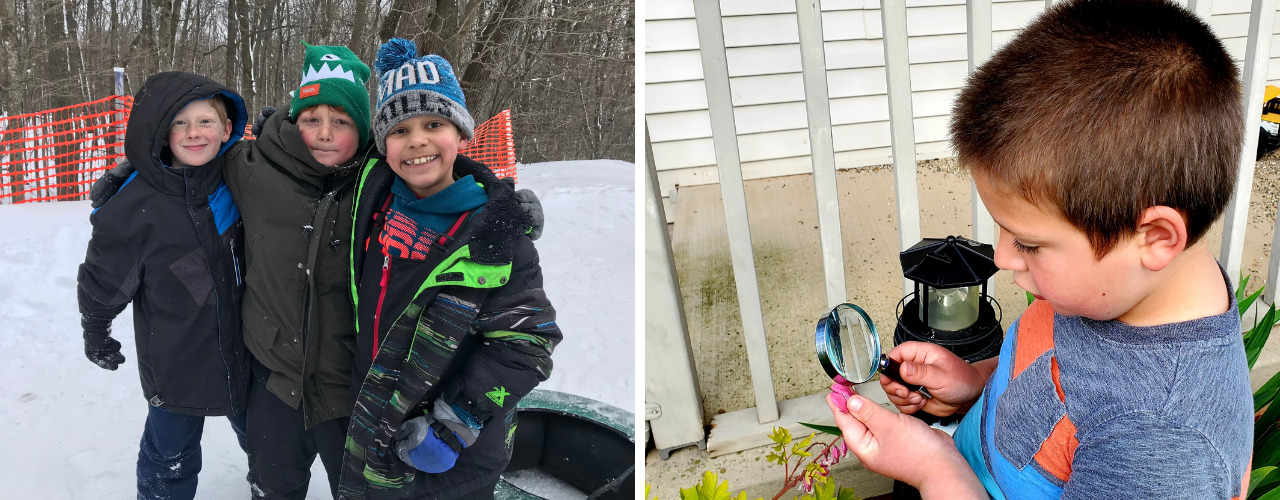
Place-based Outdoor Inquiry
Field Edventures uses a place-based outdoor inquiry approach to learning, which couples the principles of place-based education with the use of the outdoors as the context for learning. In doing so, we provide an opportunity to make learning relevant and meaningful by “bringing education back into the neighborhoods” (Sobel, 2014). Furthermore, because FIELD Edventures roots learning in the local environment for an extended period—from one month to the entire school year—students engage more deeply than during one-time field trips.
With FIELD Edventures, learning begins with investigations of the students’ place, grows into deeper understandings of the interconnectedness between human and natural systems, and evolves into actions of care and stewardship.
In a kindergarten, this might look like an investigation of whether the area around their school building is a good habitat for birds that leads the students to design and implement solutions to increase bird habitat on their school grounds. In fourth grade, a student examination into the health of the forest ecosystem in a woodlot adjacent to the school leads them to restore that woodlot and create an outdoor learning lab. And in high school, students might apply the knowledge and understandings gained by looking into why an area of the school grounds floods after heavy rains by researching and designing a solution to mitigate stormwater run-off.
Through these hands-on experiences in the real world, students gain the skills and knowledge necessary to effect change, along with the belief in their ability to do so, their sense of self-efficacy. FIELD Edventures facilitates positive change in our communities—both immediately and into the future.
FIELD Edventures is good for students as well as the health and sustainability of our communities.
Place-based outdoor inquiry has been shown to increase student academic achievement and behaviors such as school attendance and the ability to focus (Abram, 2017; Liebermann & Hoody, 1998; Louv, 2005). And there is a growing body of research revealing that time spent outdoors by children can instill a sense of joy, reduce stress, decrease negative emotions while increasing positive emotions, increase physical activity (Louv, 2005), promote social skill development, foster creativity, and improve problem solving ability, among other benefits.
FIELD Edventures is specifically designed to foster the conditions for hope.
As educators, we are interested in hope, because it is a better predictor of current and future success and wellbeing than academic achievement but it is not traditionally measured in school. Hope, as defined by EdVisions who designed the survey to measure it, “reflects individuals’ perceptions regarding their ability to clearly conceptualize their goals, develop the specific strategies to reach those goals, and initiate and sustain the activities in support of those strategies ” (EdVisions website, 12/10/18). This is what FIELD Edventures does! In putting students in the driver’s seat of their learning, place-based outdoor inquiry through FIELD Edventures teaches students how to set goals, acquire the knowledge and skills to design and implement solutions, troubleshoot obstacles and challenges, and collaborate with others.
Benefits of Outdoor Learning
The Children and Nature Network provides an extensive research database on the benefits of outdoor learning.
Our partners at the Natural Resources Foundation of Wisconsin compiled these benefits of outdoor education:
Students who participate in outdoor, nature-based learning reap cognitive, academic, physical, and emotional benefits from their experience. According to the American Academy of Pediatrics1, the American Medical Association2, the American Association of Ophthalmology3, the American Public Health Association4and the Centers for Disease Control, children who engage in outdoor, nature-based learning:
- Perform significantly better on standardized tests
- Increase academic performance by up to 27%, particularly low income students
- Are better able to concentrate and have reduced discipline problems
- Have better attendance and are less likely to drop out of school
- Have improved creativity, problem-solving skills and critical thinking abilities
- Discover increased cooperation, self-discipline, confidence and self-awareness
- Have improved performance on college entrance exams
- See a reduction of stress and mental illnesses including depression, ADD and ADHD
- Develop improved immune systems & cardiovascular health and lowered obesity
- Have improved classroom performance in math, science, reading and social studies
- Have a greater respect for themselves, for others and for the environment.
The Pew Charitable Trust’s 1998 report: Closing the Achievement Gap: Using the Environment as an Integrating Context (EIC), showed that children who participate in nature-based education programs had better performance on standardized tests in reading, writing, math, science, and social studies, reduced discipline and classroom problems, and increased engagement and enthusiasm for learning.
The American Institutes for Research’s report titled: “Effects of Outdoor Education Programs for Children in California,” focused on “at risk” youth, showed a 27% increase in mastery of science concepts; enhanced cooperation and conflict resolution skills, improved self-esteem, classroom behavior, problem solving and motivation to learn.
“When engaging children in an outdoor forest restoration project, a teacher pulled my wife aside and remarked at the way a particular student was lighting up and leading her class that day. The teacher simply said: ‘She’s special.’ My wife replied, ‘That much is obvious. She’s running the show out there.’ The teacher choked up a little and said, ‘No, you don’t understand. She’s special needs. I’ve never seen her like this. It’s just…amazing.’ – Frank Hein
Footnotes
1. |LS|American Academy of Pediatrics, “The Importance of Play in Promoting Healthy Child Development and Maintaining Strong Parent-ChildBonds,”|RS|↩
2. |LS|Burdette, H., et al. “Resurrecting Free Play in Young Children.” Children and Nature Network. 2005. 22 Oct. 2012 < http://www.childrenandnature.org/downloads/Burdette_LookingBeyond.pdf>|RS|↩
3. |LS|Sherwin, J, et al. “The Association between Time Spent Outdoors and Myopia in Children and Adolescents.” US National Library of Medicine National Institutes of Health. 2012. American Association of Ophthalmology. 22 Oct 2012. < http://www.ncbi.nlm.nih.gov/pubmed/22809757>|RS|↩
4. |LS|Kuo, PhD, Frances E., & Andrea Faber Taylor, PhD. “A Potential Natural Treatment for Attention-Deficit/Hyperactivity Disorder: Evidence From a National Study.” American Journal of Public Health 94.9.Sept. 2004. 22 Oct. 2012. |RS|↩
